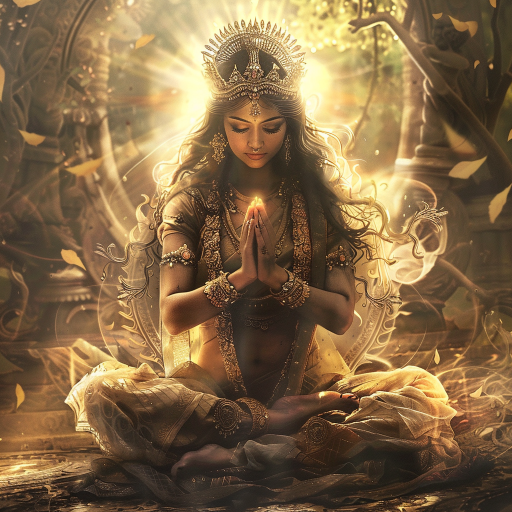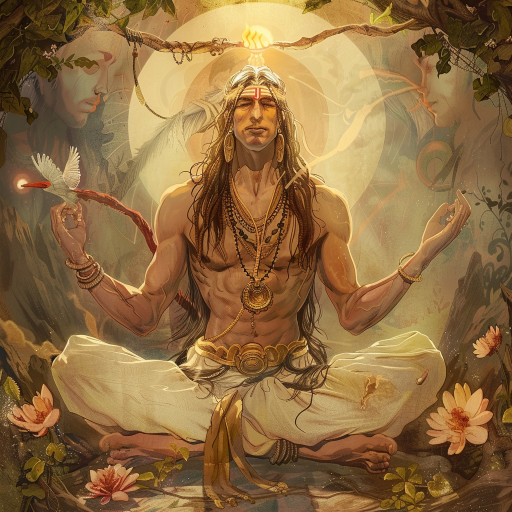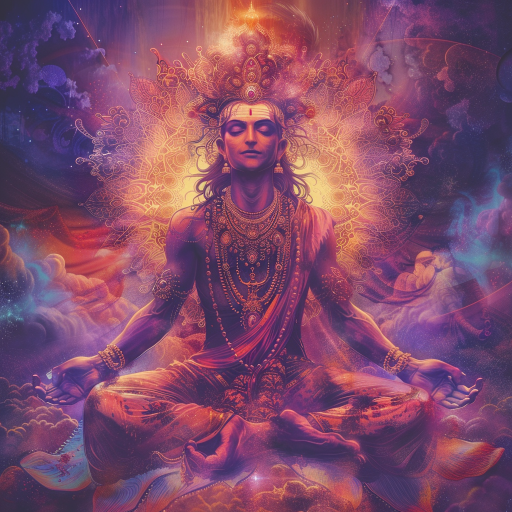The Spiritual Essence of Yoga
When we think of yoga today, images of people in trendy athletic wear performing intricate poses often come to mind. However, the original concept of yoga is far removed from these modern interpretations. Rooted in ancient spiritual practices, the 4 types of yoga aims to unite oneself with the divine, an idea encapsulated in its Sanskrit origin, “yuj,” meaning to yoke or unite.
Yoga is not just a single practice but a comprehensive system that offers various paths to accommodate different personality types. These 4 types of yoga are designed to help individuals unite with the divine in a manner that aligns with their natural inclinations. Let’s explore these four primary paths of yoga.
The Path of Love: Bhakti Yoga

For the Devotional Soul
Bhakti yoga is perfect for those who are more emotional and driven by love. It’s the path of devotion, where the practitioner seeks to unite with the divine through heartfelt love and devotion. Many religions emphasize this spiritual path as it taps into the natural human capacity for love.
In Bhakti yoga, devotees channel their powerful emotions towards loving and remembering God. This love transcends selfish desires, focusing on the divine within all beings. The Upanishads beautifully express this concept: “It is not for the sake of the husband that the husband is dear, but for the sake of the Self.”
Key Practices in Bhakti Yoga
- Devotional Attitude: Whether you see God as a parent, friend, child, or beloved, choose the relationship that feels most natural and brings you closer to the divine.
- Constant Remembrance: Regularly think of God with a longing heart.
- Service: Serve others as living manifestations of the divine.
Famous Bhakti Yogis: Meera Bai, Tulsidas, Guru Nanak.
The Path of Knowledge: Jnana Yoga

For the Intellectual Seeker
Jnana yoga is the path for those who are more intellectually inclined. It’s about using the mind to explore and realize the unity between the self (Atman) and the ultimate reality (Brahman). This path involves deep study and self-inquiry to discern the real from the unreal, the eternal from the transient.
Jnana yogis use their intellect to strip away illusions (maya) and uncover the true nature of the self. This process involves a dual approach of negation (neti, neti – not this, not this) and affirmation of the true self.
Key Practices in Jnana Yoga
- Discrimination (Viveka): Constantly differentiate between the real (eternal) and the unreal (temporary).
- Self-Inquiry: Regularly ask profound questions like “Who am I?” to deepen your understanding of the self.
- Meditation: Reflect on the teachings of spiritual texts and internalize their truths.
Famous Jnana Yogis: Adi Shankaracharya, Swami Vivekananda.
The Path of Work: Karma Yoga

For the Active Individual
Karma yoga is ideal for those who find fulfillment in action. It is the path of selfless service, where one dedicates all actions to the divine without attachment to the results. This path emphasizes performing one’s duties with a sense of detachment and offering all outcomes to a higher power.
Karma yoga teaches that by acting without selfish desires, we purify our hearts and break the cycle of cause and effect (karma) that binds us. It transforms every action into a spiritual practice.
Key Practices in Karma Yoga
- Selfless Service (Seva): Perform actions for the benefit of others without expecting any reward.
- Detachment: Focus on the action itself, not the results.
- Duty: Follow your dharma (true purpose) and perform your duties with dedication.
Famous Karma Yogis: Mother Teresa, Mahatma Gandhi.
The Path of Meditation: Raja Yoga

For the Meditative Soul
Raja yoga is the royal path of meditation, focusing on controlling the mind and body to realize the divine self. It involves practices that help calm the mind and achieve deep states of meditation. The ultimate goal is to experience the Atman (true self) directly.
Raja yoga includes the eightfold path (Ashtanga) outlined by Patanjali in the Yoga Sutras. These steps guide practitioners through ethical conduct, physical postures, breath control, and deep meditation.
Key Practices in Raja Yoga
- Ethical Guidelines (Yamas and Niyamas): Live a life of non-violence, truthfulness, purity, and discipline.
- Physical Postures (Asanas): Maintain a healthy body through yoga poses.
- Breath Control (Pranayama): Regulate the life force through controlled breathing.
- Meditation (Dhyana): Practice deep, focused meditation to quiet the mind.
Famous Raja Yogis: Swami Vivekananda, B.K.S. Iyengar.
Interweaving the Paths
While each of these paths caters to different psychological types, they are not mutually exclusive. In fact, they often overlap and complement each other, creating a holistic approach to spiritual growth. For instance, a Bhakti yogi can also practice Karma yoga by serving others selflessly, or a Jnana yogi can incorporate Raja yoga techniques to deepen their meditation practice.
The Ultimate Goal: Moksha
All these paths ultimately lead to the same goal—Moksha, or liberation. This state represents freedom from ignorance and the realization of one’s true nature as part of the divine. It’s about understanding that we are not just our bodies or minds, but something much more profound and eternal.
Embracing Yoga in Everyday Life
To incorporate yoga into your daily life, start by identifying which path resonates most with you. You don’t need to strictly follow one path; instead, blend practices from different paths to create a balanced spiritual routine. Here’s a simple way to get started:
- Bhakti Yoga: Dedicate a few minutes daily to prayer or singing hymns.
- Jnana Yoga: Spend time reading spiritual texts and reflecting on their meanings.
- Karma Yoga: Engage in selfless acts of service, like volunteering or helping a neighbor.
- Raja Yoga: Practice meditation and mindfulness exercises regularly.
Conclusion: Finding Your Path
Yoga offers a rich tapestry of practices designed to suit different personalities and temperaments. Whether you’re drawn to the path of love, knowledge, action, or meditation, there’s a yoga path that can guide you towards spiritual fulfillment and inner peace. Embrace the path that feels right for you, and let it lead you to a deeper understanding of yourself and your connection to the divine.
Remember: The journey of yoga is personal and transformative. As you explore these paths, you’ll find that they all lead to the same ultimate truth—the realization of your true self and unity with the divine.
Frequently Asked Questions
What are the 4 yogas in the Gita?
In the Bhagavad Gita, there are four main paths of yoga:
- Karma Yoga: This is the yoga of action and selfless service. It’s great for people who are active and enjoy being involved in their community.
- Bhakti Yoga: This path is all about devotion and love for the divine. It’s perfect for those who are more heart-centered and emotionally driven.
- Rāja Yoga: Known as the yoga of meditation, this path focuses on achieving mental control and self-discipline.
- Jñāna Yoga: This is the yoga of wisdom and intellect, ideal for those who seek knowledge and understanding through study and contemplation.
How many types of yoga are there in the Vedas?
The Vedas and the Upanishads mention four primary types of yoga:
- Mantra Yoga: This involves the repetition of sacred sounds or phrases.
- Laya Yoga: This type of yoga focuses on merging the individual consciousness with the universal consciousness.
- Raja Yoga: Known for its meditative practices and mental control.
- Hatha Yoga: This is the yoga of physical postures and breath control.
In the Bhagavad Gita, there are additional types such as:
- Karma Yoga: The path of selfless action.
- Jnana Yoga: The path of knowledge.
- Karma Sanyasa Yoga: The yoga of renunciation of action.
- Buddhi Yoga: The yoga of wisdom.
- Bhakti Yoga: The path of devotion.
What are the 4 pillars of Karma Yoga?
The four main principles of Karma Yoga are:
- Duty: Performing one’s responsibilities sincerely.
- Ego: Acting without attachment to ego or personal gain.
- Attachment: Letting go of attachment to the results of actions.
- Expectation of Reward: Performing actions selflessly, without expecting any rewards in return.
What is spiritual yoga called?
Kundalini yoga is often considered more spiritual than other forms of yoga. Unlike other types that flow with the breath, Kundalini yoga includes chanting, singing, specific movements, and breathing patterns. The goal is to achieve spiritual enlightenment, and it’s known for its many science-backed benefits.
Who was the first yogi?
In yogic tradition, Shiva is regarded as the first yogi, or Adiyogi, and the first Guru, or Adi Guru. Thousands of years ago, on the banks of Lake Kantisarovar in the Himalayas, Adiyogi shared his profound knowledge with the seven legendary sages, known as the Saptarishis.





